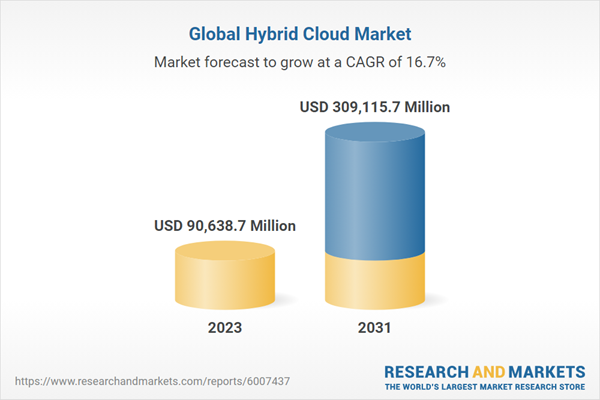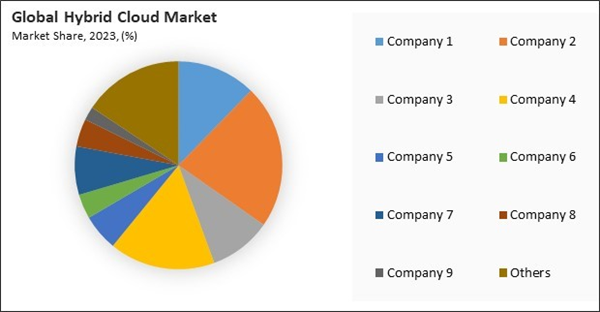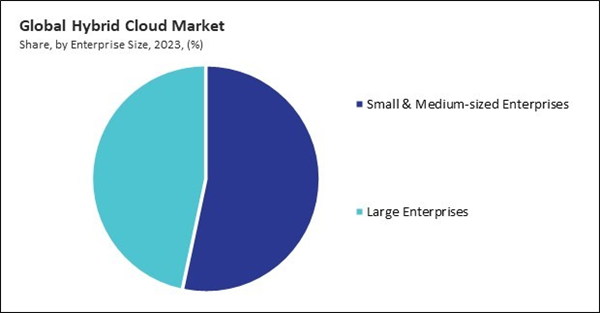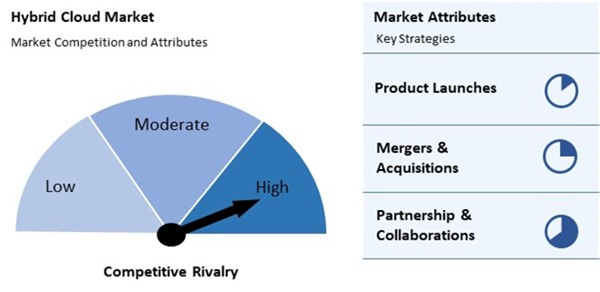The Global Hybrid Cloud Market size is expected to reach $309.1 billion by 2031, rising at a market growth of 16.7% CAGR during the forecast period.
Healthcare organizations generate massive amounts of data, from patient records to medical imaging. The hybrid cloud offers scalable storage solutions that can handle big data efficiently, ensuring that data is accessible and manageable. Hybrid cloud solutions provide robust disaster recovery options by allowing data to be replicated and backed up in the cloud, ensuring business continuity in case of hardware failures or other disruptions. Thus, the healthcare segment recorded 16% revenue share in the hybrid cloud market.
The major strategies followed by the market participants are Partnership as the key developmental strategy to keep pace with the changing demands of end users. For instance, In August, 2024, Dell Technologies and Nutanix have announced an expansion of their 14-year partnership with the introduction of new hybrid cloud solutions. The Dell XC Plus HCI appliance, combining Nutanix software with Dell PowerEdge servers, simplifies management. Additionally, Dell PowerFlex will support the Nutanix Cloud Platform, enhancing scalability.
Additionally, hybrid cloud solutions support this by providing a framework for seamlessly integrating and managing these diverse cloud environments. Thus, the increasing adoption of multi-cloud strategies propels the market’s growth.
The leading players in the market are competing with diverse innovative offerings to remain competitive in the market. The above illustration shows the percentage of revenue shared by some of the leading companies in the market. The leading players of the market are adopting various strategies in order to cater demand coming from the different industries. The key developmental strategies in the market are Partnerships & Collaborations.
The Market is highly competitive with key players like Microsoft, IBM corporation, and Google Cloud dominating. Attributes driving competition include scalability, flexibility, and security enhancements offered by hybrid models. Demand is fueled by businesses seeking to leverage both public and private cloud benefits, optimizing cost-efficiency and data management. Emerging trends include edge computing integration and AI-driven workload management, influencing market dynamics and innovation.
Healthcare organizations generate massive amounts of data, from patient records to medical imaging. The hybrid cloud offers scalable storage solutions that can handle big data efficiently, ensuring that data is accessible and manageable. Hybrid cloud solutions provide robust disaster recovery options by allowing data to be replicated and backed up in the cloud, ensuring business continuity in case of hardware failures or other disruptions. Thus, the healthcare segment recorded 16% revenue share in the hybrid cloud market.
The major strategies followed by the market participants are Partnership as the key developmental strategy to keep pace with the changing demands of end users. For instance, In August, 2024, Dell Technologies and Nutanix have announced an expansion of their 14-year partnership with the introduction of new hybrid cloud solutions. The Dell XC Plus HCI appliance, combining Nutanix software with Dell PowerEdge servers, simplifies management. Additionally, Dell PowerFlex will support the Nutanix Cloud Platform, enhancing scalability.
Cardinal Matrix - Market Competition Analysis
Based on the Analysis presented in the Cardinal matrix; Microsoft Corporation and Google LLC are the forerunners in the Hybrid Cloud Market. Companies such as IBM Corporation, Cisco Systems Inc. and Oracle Corporation are some of the key innovators in Hybrid Cloud Market. In January, 2024, Microsoft Corporation and Vodafone Group Plc have entered into a 10-year strategic partnership aimed at advancing digital services and cloud capabilities. This alliance will leverage Microsoft's AI and cloud technologies to enhance customer experiences, expand Vodafone’s IoT platform, and promote financial inclusion across Africa.Market Growth Factors
For businesses with specific compliance and data sovereignty requirements, hybrid clouds can keep sensitive data in a private cloud while utilizing public clouds for other functions. This approach helps meet regulatory standards and ensures data protection without sacrificing the benefits of cloud computing. In conclusion, increased demand for flexibility and scalability drives the market’s growth.Additionally, hybrid cloud solutions support this by providing a framework for seamlessly integrating and managing these diverse cloud environments. Thus, the increasing adoption of multi-cloud strategies propels the market’s growth.
Market Restraining Factors
Training existing staff or hiring new experts can be costly and add to the ongoing operational expenses. While hybrid cloud solutions can optimize resource use, organizations must still pay for both public cloud services and private cloud infrastructure. Ensuring efficient utilization of these resources is crucial to managing costs, but inefficiencies can lead to higher ongoing expenses. Therefore, high initial capital expenditure and ongoing operational costs impede the market’s growth.The leading players in the market are competing with diverse innovative offerings to remain competitive in the market. The above illustration shows the percentage of revenue shared by some of the leading companies in the market. The leading players of the market are adopting various strategies in order to cater demand coming from the different industries. The key developmental strategies in the market are Partnerships & Collaborations.
Driving and Restraining Factors
Drivers
- Increased Demand for Flexibility and Scalability
- Increasing Adoption of Multi-Cloud Strategies
- Digital Transformation Initiatives
Restraints
- High Initial Capital Expenditure and Ongoing Operational Costs
- Network Latency and Performance Issues Affecting Critical Applications
Opportunities
- Supporting Robust Disaster Recovery and Business Continuity Plans
- Increasing Remote Work and Collaboration Needs
Challenges
- Rapidly evolving cyber threat landscape
- Challenges with integration and interoperability across diverse IT systems
Services Model Outlook
By services model, the market is segmented into software as a service (SaaS), infrastructure as a service (IaaS), and platform as a service (PaaS). The infrastructure as a service (IaaS) segment procured 34% revenue share in the market in 2023. IaaS enables rapid provisioning of computing resources, storage, and networking.Enterprises Size Outlook
On the basis of enterprise size, the market is segmented into large enterprises and small & medium-sized enterprises. In 2023, the small & medium-sized enterprises segment attained 47% revenue share in the market. solutions allow SMEs to minimize upfront investments in physical infrastructure.Industry Vertical Outlook
By industry vertical, the market is divided into IT & telecom, healthcare, BFSI, retail, government, media & entertainment, transportation & logistics, manufacturing, and others. In 2023, the BFSI segment registered 21% revenue share in the market. The BFSI sector is subject to stringent regulatory requirements and compliance standards, such as GDPR, PCI-DSS, and SOX.Component Outlook
Based on component, the market is divided into solution and services. In 2023, the services segment garnered 37% revenue share in the market. Hybrid cloud environments involve integrating on-premises systems with multiple cloud services, which can be complex.By Regional Analysis
Region-wise, the market is analyzed across North America, Europe, Asia Pacific, and LAMEA. The North America region witnessed 38% revenue share in the market in 2023. North America, especially the United States and Canada, has a highly developed and mature IT infrastructure.Market Competition and Attributes
The Market is highly competitive with key players like Microsoft, IBM corporation, and Google Cloud dominating. Attributes driving competition include scalability, flexibility, and security enhancements offered by hybrid models. Demand is fueled by businesses seeking to leverage both public and private cloud benefits, optimizing cost-efficiency and data management. Emerging trends include edge computing integration and AI-driven workload management, influencing market dynamics and innovation.
Recent Strategies Deployed in the Market
- Aug-2024: Dell Technologies and Nutanix have announced an expansion of their 14-year partnership with the introduction of new hybrid cloud solutions. The Dell XC Plus HCI appliance, combining Nutanix software with Dell PowerEdge servers, simplifies management. Additionally, Dell PowerFlex will support the Nutanix Cloud Platform, enhancing scalability.
- Jun-2024: Lumen Technologies and Microsoft Corporation announced a strategic partnership to advance digital transformation and AI. Lumen’s Private Connectivity Fabric℠ will boost Microsoft’s network capacity for Azure, supporting AI initiatives and digital transformation while saving costs.
- Jun-2024: Teradata is pleased to announce the integration of Teradata VantageCloud Lake with Google Cloud, a strategic move designed to enhance AI and analytics capabilities for enterprises. This integration combines Teradata's ClearScape Analytics with Google Cloud’s Vertex AI and Gemini models, creating a powerful platform for efficient data processing and advanced AI experimentation.
- May-2024: Teradata and AWS have expanded their partnership to boost cloud migration and AI capabilities. The agreement integrates Teradata VantageCloud with AWS services, including Amazon Bedrock, to provide advanced, scalable cloud solutions and support for generative AI applications.
- May-2024: SAP SE came into partnership with Accenture plc to enhance ERP transformation and generative AI adoption. The collaboration aims to improve business performance and productivity by integrating SAP’s technology with AI-enabled solutions, accelerating transitions to SAP S/4HANA Cloud, and optimizing enterprise processes.
List of Key Companies Profiled
- Amazon Web Services, Inc. (Amazon.com, Inc.)
- Microsoft Corporation
- Google LLC
- IBM Corporation
- Oracle Corporation
- SAP SE
- Salesforce, Inc.
- Dell Technologies, Inc.
- Equinix, Inc.
- Nutanix, Inc.
Market Report Segmentation
By Component
- Solution
- Services
By Enterprise Size
- Small & Medium-sized Enterprises
- Large Enterprises
By Service Model
- Software as a Service (SaaS)
- Infrastructure as a Service (IaaS)
- Platform as a Service (PaaS)
By Industry Vertical
- BFSI
- IT & Telecom
- Healthcare
- Retail
- Government
- Media & Entertainment
- Transportation & Logistics
- Manufacturing
- Others
By Geography
- North America
- US
- Canada
- Mexico
- Rest of North America
- Europe
- Germany
- UK
- France
- Russia
- Spain
- Italy
- Rest of Europe
- Asia Pacific
- China
- Japan
- India
- South Korea
- Singapore
- Malaysia
- Rest of Asia Pacific
- LAMEA
- Brazil
- Argentina
- UAE
- Saudi Arabia
- South Africa
- Nigeria
- Rest of LAMEA
Table of Contents
Chapter 1. Market Scope & Methodology
Chapter 2. Market at a Glance
Chapter 3. Market Overview
Chapter 4. Competition Analysis - Global
Chapter 5. Global Hybrid Cloud Market by Component
Chapter 6. Global Hybrid Cloud Market by Enterprise Size
Chapter 7. Global Hybrid Cloud Market by Service Model
Chapter 8. Global Hybrid Cloud Market by Industry Vertical
Chapter 9. Global Hybrid Cloud Market by Region
Chapter 10. Company Profiles
Companies Mentioned
- Amazon Web Services, Inc. (Amazon.com, Inc.)
- Microsoft Corporation
- Google LLC
- IBM Corporation
- Oracle Corporation
- SAP SE
- Salesforce, Inc.
- Dell Technologies, Inc.
- Equinix, Inc.
- Nutanix, Inc.
Methodology

LOADING...
Table Information
| Report Attribute | Details |
|---|---|
| No. of Pages | 330 |
| Published | September 2024 |
| Forecast Period | 2023 - 2031 |
| Estimated Market Value ( USD | $ 90638.7 Million |
| Forecasted Market Value ( USD | $ 309115.7 Million |
| Compound Annual Growth Rate | 16.7% |
| Regions Covered | Global |
| No. of Companies Mentioned | 10 |












